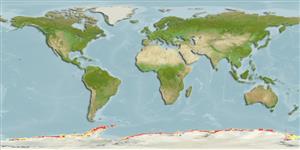>
Perciformes/Notothenioidei (Icefishes) >
Nototheniidae (Cod icefishes) > Trematominae
Etymology: Trematomus: Greek, trematos = hole + Greek, tomo = section, cut (Ref. 45335); newnesi: newnesi named after Sir George Newnes, British newspaper publisher who sponsored Borchgrevinck's Expedition of 1899 (Ref. 11892).
More on author: Boulenger.
Environment: milieu / climate zone / depth range / distribution range
Écologie
marin démersal; profondeur 0 - 400 m (Ref. 11892). Polar; 60°S - 78°S
Southern Ocean: East Antarctic, Weddell Sea, West coast of Antarctic Peninsula, South Shetland Islands, Elephant Island, South Orkney Islands, Mac Robertson, George V, Queen Mary, Adelie Coasts, Davis Sea and Ross Sea.
Taille / Poids / Âge
Maturity: Lm ? range ? - ? cm
Max length : 24.5 cm TL mâle / non sexé; (Ref. 58849)
Épines dorsales (Total): 5 - 8; Rayons mous dorsaux (Total): 29-38; Rayons mous anaux: 29 - 36
Found in shallow near shore areas and more commonly in the intertidal zone. Adults feed mainly on amphipods, polychaetes, gastropods, isopods, copepods, and euphausiids (E. superba). Often seen feeding in the water column or at the undersurface of ice.
Life cycle and mating behavior
Maturité | Reproduction | Frai | Œufs | Fécondité | Larves
Dewitt, H.H., P.C. Heemstra and O. Gon, 1990. Nototheniidae. p. 279-331. In O. Gon and P.C. Heemstra (eds.) Fishes of the Southern Ocean. J.L.B. Smith Institute of Ichthyology, Grahamstown, South Africa. (Ref. 5179)
Statut dans la liste rouge de l'IUCN (Ref. 130435)
Menace pour l'homme
Harmless
Utilisations par l'homme
Pêcheries: sans intérêt
Plus d'informations
RéférencesAquacultureProfil d'aquacultureSouchesGénétiqueElectrophoresesHéritabilitéPathologiesTraitementNutrientsMass conversion
CollaborateursImagesStamps, Coins Misc.SonsCiguateraVitesseType de nageSurface branchialeOtolithesCerveauxVision
Outils
Articles particuliers
Télécharger en XML
Sources Internet
Estimates based on models
Preferred temperature (Ref.
123201): -1.8 - -0.4, mean -1.4 °C (based on 237 cells).
Phylogenetic diversity index (Ref.
82804): PD
50 = 0.5005 [Uniqueness, from 0.5 = low to 2.0 = high].
Bayesian length-weight: a=0.00537 (0.00280 - 0.01029), b=3.24 (3.07 - 3.41), in cm total length, based on LWR estimates for this Genus-body shape (Ref.
93245).
Niveau trophique (Ref.
69278): 3.2 ±0.2 se; based on diet studies.
Generation time: 3.1 ( na - na) years. Estimated as median ln(3)/K based on 2
growth studies.
Résilience (Ref.
120179): Milieu, temps minimum de doublement de population : 1,4 à 4,4 années (Fec = 2,300-12,200).
Fishing Vulnerability (Ref.
59153): Low to moderate vulnerability (28 of 100).
